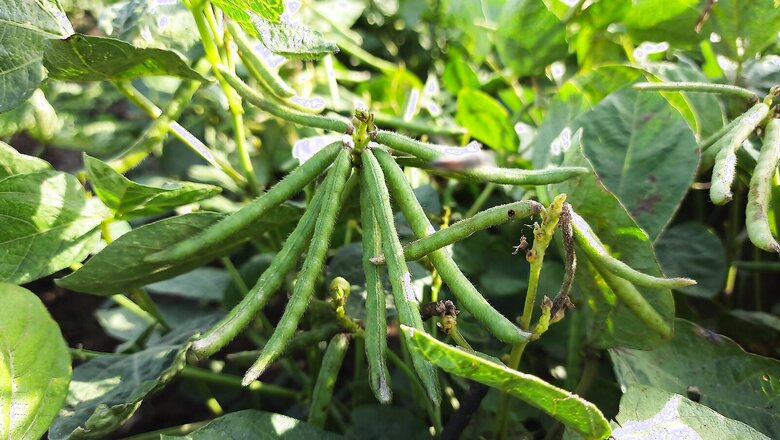
views
In an attempt to give impetus to crop diversification, water conservation and supplement farmers’ income, the moong crop is likely to be the driving force for a change in the cropping pattern in Punjab. Farmers have taken a lead by sowing moong, a 65-day crop, between wheat-paddy cycles to make the country self-reliant in pulse production.
For the first time, in a notable effort by chief minister Bhagwant Mann the state has pitched support for procurement of moong at MSP (minimum support price) — this has resulted in moong cultivation this year increasing to 1.25 lakh acres from 55,000 acres in 2020-21. Earlier, sowing alternative crops, other than rice and wheat, remained a challenge for farmers because of the MSP conundrum.
To encourage crop diversification, we must consider its overall impact towards improving economic resilience of the agricultural landscape, mitigating price volatility and fighting climate change.
Such a step would ultimately motivate the farmers to cultivate less water-consuming varieties of paddy, including Basmati, to check the fast-depleting water table levels in the state. Farmers take about 4200 litres of water to grow one kg of rice — this explains Punjab’s low water productivity. At least 131 of the 148 blocks in the state are overexploited. Water table levels in Bathinda, Mansa, Moga, Sri Muktsar Sahib and Ludhiana in the Malwa region were notoriously degraded. Now, these five districts are leading in moong cultivation (91,472 acres) this season.
Punjab occupies a dominant place in the growth of agriculture in India since the advent of the Green Revolution. There was a shift in the cropping pattern from crop diversification to mono-cropping, and over time, the share of the area under different crop groups of coarse cereals, pulses, oilseeds, cotton, sugarcane among others fell compared to an increase in the share of wheat and paddy (which is at 84 per cent). This has had serious repercussions for the environment, including decline in groundwater levels, soil degradation due to intensive use of fertilizers and pesticides.
At the cost of its natural resources, Punjab propelled India’s Green Revolution, rescuing millions from hunger but the gains are fast eroding. The income slowdown is linked to an overdependence on wheat and rice because assured MSP has caused Punjab’s rich landscape of lentils, corn, barley, gram and nutritious coarse cereals to disappear within a decade of wheat and paddy entering the state in the late 1960s. The number of crops grown by Punjab’s farmers has declined from 21 in 1960s to just about nine. During 1970-71, the area under paddy cultivation in Punjab stood at 3.9 lakh hectares, which increased to 31.45 lakh hectares in 2021-22. Wheat has been one the dominant crops since its introduction in Punjab (1975-76), covering 38.99 per cent of the area under cultivation.
To promote diversified cropping patterns, crops other than cereals should be competitive in terms of their net returns. There is no doubt that crop diversification in Punjab has declined year-on-year due to mono-cropping. Cereals have been the principal crop in Punjab, covering the largest share in area under cultivation over the last five decades.
The success of the pilot project — encouraging Punjab farmers to diversify and take up cultivation of moong — should be replicated for other vital crops as well. India requires 30 million tonnes of pulses per year to meet domestic demands and we are still importing around 4 million tonnes of pulses every year. The government has saved Rs 15,000 crore annually by reducing its dependence on import of pulses as the domestic production has gone up from 14 million tonnes to 24 million tonnes during 2014-2021. The savings by the government exchequer due to reduced imports should be passed on to farmers to make India self-reliant in pulses.
How MSP Policy Will Help Promote Crop Diversification
Any sustainable solution, as I have suggested earlier, will have to ensure that crop groups other than cereals are competitive in terms of their net returns against wheat and paddy. The need for sustainable agriculture through water conservation in irrigation demands promotion of more research into and development of high-yielding varieties.
The MSP policy is being used to promote crop diversification as well as the processing sector, which is not only a major market for agricultural produce but also a significant employer of the surplus workforce engaged in agriculture. The government is facilitating food processing through various measures like infrastructure development, subsidised transportation and support for formalisation of rural micro-food enterprises, like dal and flour mills.
The sale of wheat and paddy is executed in the local markets in Punjab but farmers have to travel to the main market yard for sale of other crops. It is, therefore, suggested that the policy support for agricultural marketing of other crops may be redesigned with proper strategy.
The Way Forward
Apart from ensuring procurement of maximum crops by government agencies at MSP, science- and technology led diversification, away from the paddy-wheat system to conservation farming and horticultural revolution, should be encouraged. Crop diversification will be successful only if it responds to global market changes, export incentives and agro-ecological settings. It will increase employment and income generation along with judicious use of land, water, labour and biodiversity conservation in rural Bharat.
The writer is Vice Chairman, Sonalika Group and Former Vice Chairman, Punjab Planning Board. The views expressed in this article are those of the author and do not represent the stand of this publication.
Read all the Latest Opinions here



















Comments
0 comment